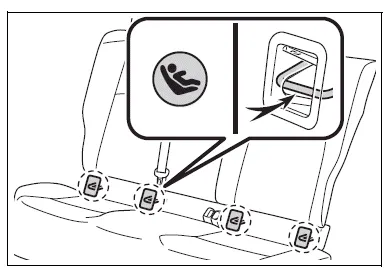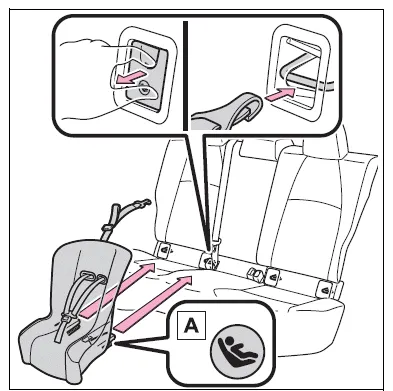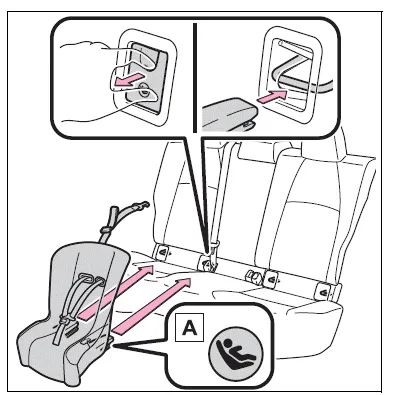Toyota Corolla (E210) 2019-2025 Owners Manual / For safety and security / Child safety / Child restraint system
fixed with a child restraint
LATCH anchor (except for
Puerto Rico)
Toyota Corolla (E210): Child restraint system fixed with a child restraint LATCH anchor (except for Puerto Rico)
■ Child restraint LATCH anchors
LATCH anchors are provided for the outboard rear seat. (Marks displaying the location of the anchors are attached to the seats.)

■ When installing in the rear outboard seats
Install the child restraint system in accordance to the operation manual enclosed with the child restraint system.
With flexible lower attachments
1. Remove the anchor covers, and install the child restraint system to the seat.
The bars are installed behind the anchor covers.
For owners in Canada: The symbol on a child restraint system indicates A the presence of a lower connector system.

- Canada only
With rigid lower attachments
1. Remove the anchor covers, and install the child restraint system to the seat.
The bars are installed behind the anchor covers.
For owners in Canada: The symbol on a child restraint system indicates A the presence of a lower connector system.

- Canada only
2. If the child restraint has a top tether strap, follow the child restraint manufacturer's operation manual regarding the installation, using the top tether strap to latch onto the top tether strap anchor.
3. After installing the child restraint system, rock it back and forth to ensure that it is installed securely.
■ When installing in the rear center seat
There are no LATCH anchors behind the rear center seat.
However, the inboard LATCH anchors of the outboard seats, which are 15.6 in. (396 mm) apart, can be used if the child restraint system manufacturer's instructions permit use of those anchors with the anchor spacing stated.
Child restraint systems with rigid lower attachments cannot be installed in the center seat. This type of child restraint system can only be installed in the outboard seat.
■Laws and regulations pertaining to anchors
The LATCH system conforms to FMVSS225 or CMVSS210.2.
Child restraint systems conforming to FMVSS213 or CMVSS213 specifications can be used.
This vehicle is designed to conform to SAE J1819.
WARNING
■When installing a child restraint system
Observe the following precautions.
Failure to do so may result in death or serious injury.
- When using the LATCH anchors, be sure that there are no foreign objects around the anchors and that the seat belt is not caught behind the child restraint system.
- Follow all installation instructions provided by the child restraint system manufacturer.
- Never attach two child restraint system attachments to the same anchor. In a collision, one anchor may not be strong enough to hold two child restraint system attachments and may break. If the LATCH anchors are already in use, use the seat belt to install a child restraint system in the center seat.
- When securing some types of
child restraint systems in rear
seats, it may not be possible to
properly use the seat belts in
positions next to the child
restraint without interfering with
it or affecting seat belt effectiveness.
Be sure your seat belt fits snugly across your shoulder and low on your hips. If it does not, or if it interferes with the child restraint, move to a different position. Failure to do so may result in death or serious injury.
- If the seat is adjusted, reconfirm the security of the child restraint system.
Other materials:
Disposal
Hint:
when scrapping vehicle equipped with an srs or disposing of a horn button assy,
always first deploy the
airbag in accordance with the procedure described below. If any abnormality
occurs in the airbag deployment,
contact the service dept. Of toyota motor sales, u.S.A., Inc.
Caution:
...
Rear view monitor system precautions
■ Area displayed on screen
The rear view monitor system displays an image of the view from the bumper of
the rear area of the vehicle.
To adjust the image on the rear view monitor system screen.
• The area displayed on the screen may vary according to vehicle orientation
conditions.
...
Steering column
Preparation
Sst
Recomended tools
Equipment
...


